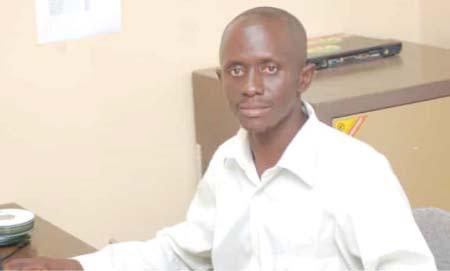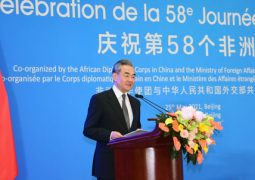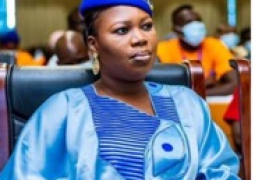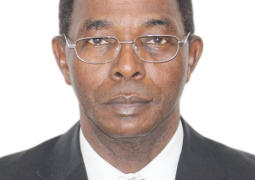
The training is part of the legal mandates of the Copyright Office as per section 56 and 57 of the 2004 Copyright Act and section 6 of the 2018 Copyright Regulations, Laws of The Gambia.
The program drew participants from various copyright and related rights industries as fashion, kanyelling groups, performing artist, media, security outfits as police, immigration, SIS, Gambia Tourissm Board among others and the official ceremony was presided over by the Deputy Governor DemboSamateh and moderated by SannaJawara, head of Copyright Office assisted by Fatima Camara, Copyright Inspector.
It was characterized by intensive interactive presentations and discussions matters affecting effective and sustainable development of Copyright and Related Rights in The Gambia and what needs to be done to have an effective and sustainable system to that effect for the benefit of stakeholders and the country as a whole.
MrDemboSamateh, Deputy Governor expressed deep sense of honor and appreciation to the copyright team for engaging the people of the region on such an important issue that has the potentials of lifting the country out poverty once its effectively and sustainably utilized.
He urged participants to make use of the training and share experience with those not presence at the occasion and he hope similar exercise would be held in other regions of the country owing the importance of the subject matter for national discussion and effective action.
SannaJawara, Head of Copyright Office outlined the objectives of the training, functions of the Copyright Office and the need for stakeholders engage the office for effective operations and sustainability activities to that effect.
Copyright Protection
Generally, we mean certain uses of the work are lawful only if they are done with the authorization of the owner.
It offered legal protection to stakeholders in the Cultural and Creative Industries. I am pretty sure, such was the rationale behind placing Copyright and Related Rights administration and coordination under the Ministry of Tourism and Culture, through the National Centre for Arts and Culture as per section 56 of the cited 2004 Copyright Act.
The invention of movable type and printing press by Johannes Gutenberg in 1440 and its spread provoked the need for copyright law
The first Copyright Act also known as the Statute of Anne was passed in Great Britain in 1709.
Functions;
Section 57 of the Copyright Act, outlined the functions of the Copyright Office/ NANC shall; (a) be responsible for all matters affecting Copyright and Related Rights in The Gambia, (b) Monitor and Supervise The Gambia’s position in relation to International Treaties, Conventions, and Protocols and advise Government accordingly (c ), Enlighten and inform the public on all matter relating to Copyright and Related Rights (d), maintain an effective data bank on authors and other owners of Copyright and Related Rights and their works (e ), Undertake such other tasks relating to Copyright and Related Rights as the Secretary of State/ Minister may assign to it.
Objectives;
Promoting and Protecting issues not limited to the following;
- Originality; as no one wants to be called fake, almost everyone wants to be original in their space and capacities, which is further reflected in what we do, including the clothing and gadgets we use. So why not have law promoting and protecting that concept of originality in line with our unique human creation as no two or more human beings are created exactly the same?
As such, Originality in this sense means the work or product is the author’s own creation and is not totally copied.
We have either seen or heard about the implications of counterfeit products, especially in the world of medicine on our health and lives.
The impact examination malpractices in our schools, plagiarism related matters on our growth and strengthen in education and professional domaains.
- Creativity; as most people would call it “The mother creation”. Imagine a life without creativity to make life better and enjoyable on this planet. Examples are not limited to the first Computers Created in 18 or 19 Centuries compared to modern-day Laptops, Tablets, and Smart Phones such as iPhones in both size and speed.
- Innovation; we cannot stop creating products and services, we must keep dancing around them, through constant innovation sustaining our products and services, and this is specifically true for the sector players. For example the main sponsor of this program with Afri-Money with an innovative and magnate name as the leading GSM Service Provider in The Gambia.
- Entrepreneurship; Creating opportunities for each other, through job and wealth creation as no Government in the world can employ all its citizens, hence the importance of private employers in the world of entrepreneurship.
They are the major stakeholders in the Creative and Cultural Industries and the largest employer in any given country, including The Gambia, putting food on the tables of many through the provision of job opportunities. Balance this against the ongoing illegal migration the bulk of our youth to Europe for greener pasture
Different Rights Offered by Copyright
- Moral Rights;
The right to claim and to be identified as the author or copyright owner or except omission dictated by the use of the work or performance
The right to object to any distortion, mutilation or other modification of the copyright work that would be prejudicial to the reputation of the author or copyright owner taking due account of the nature of the work
2.Economic Rights, are not limited to the following;
(a). Reproduction Right
(b). Distribution Right
(c ) Right of Rental
(d) Right of Communicating to the public and also making it available to the public
The Creative Economy
Creative Economy and entrepreneurship is about a business having at the heart of its business creativity and creative-related activities
Examples;
- Fashion Industry
- Music Industry
- Advertisement Industry
- Publishing Industry
- Broadcasting Industry, including TV and Radio Stations on both print and electronic
- Performing Industry see live bands as JalibaKuyateh, Bob Marley amonthers and potential jobs they created
- Our Folklore and Cultural Expressions;
See Kabagel, Siko Music, Kanyelleing, Kankurang among others
Promoting Indigenous Languages as a vehicle for achieving sustainable human development. Languages are central to the identity of indigenous peoples and the preservation of their cultures. It’s a worldview vision and expression of self-determination.
For indigenous peoples, languages did not only identify their origin or membership in a community but also carry the ethical values of their ancestors
The Swakopmund Protocol on Protection of Traditional Knowledge and Expressions of Folklore, 2019 and Ratified by The Gambia in 2015
This ProtocolRecognizes the intrinsic value of traditional knowledge, traditional cultures and folklore, including their social, cultural, spiritual, economic, intellectual, scientific, ecological, agricultural, medical, technological, commercial, and educational value
- Computer Gaming, Video gaming
Different Ways of Copyright Enforcement in the Digital Environment
Direct Removal
Direct removal is the most simple and basic tactic as it involves finding infringing content online and taking it down. This can take the form of different ways, including takedown notices, Content removals on Youtube, lawsuits against infringing companies, police raids against large-scale piracy sites and others.
- Blocking/Restricting Access
This strategy is relatively new in terms of mass piracy enforcement, but the basic idea is that, rather than removing the infringing files, sites or services, one simply tries to block or restricting access to it.
What is Intellectual Property (IP)
Intellectual Property (IP) is divided into two branches such as;
- Copyright and Related Rights, which protects literary and artistic works in the cultural and creative industries and this was inspired by the 1709 Statutes of Anne, the first Copy Law in Great Britain, followed by 1886 Berne Convention for Protection of Literary and Artistic Works, which further inspired the 2004 Copyright Act and 2018 Copyright Regulations, Laws of The Gambia, hence Copyright Office placed under National Centre for Arts and Culture (NCAC) with Ministry of Tourism and Culture having the portfolio
- Industrial Property inspired by the 1883 Paris Convention for protection of Industrial Property (IP), which further inspired the Industrial Property Act and Industrial Property Regulations, Laws of The Gambia, hence Industrial Property Office placed under the Ministry of Justice and Attorney General Chambers, protecting trademarks, patents, industrial design by Industrial
Recommendation
The participants suggested issues not limited to the following for an effective and function Copyright and Related Rights system for the creative and cultural industries development;
- Invest and support stakeholders in the sector in both moral and financial support at local, regional and international level
- Establish Music School for the sector as a breeding ground for promoting quality in the sector like other countries, including our sister country of Senegal
- Establish performing and Recreational Centers in the country
- Organise more similar capacity building and awareness training for stakeholders across the country




